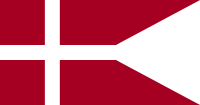Danish Navy
The Royal Danish Navy (Danish: Søværnet) is the sea-based branch of the Danish Defence force. The RDN is mainly responsible for maritime defence and maintaining the sovereignty of Danish, Greenlandic and Faroese territorial waters. Other tasks include surveillance, search and rescue, icebreaking, oil spill recovery and prevention as well as contributions to international tasks and forces.
During the period 1509–1814, when Denmark was in a union with Norway, the Danish Navy was part of the Dano-Norwegian Navy. Until the copenhagenization of the navy in 1807, the navy was a major strategic influence in the European geographical area, but since then its size and influence has drastically declined with a change in government policy. Despite this, the navy is now equipped with a number of large state-of-the-art vessels commissioned since the end of the Cold War. This can be explained by its strategic location as the NATO member controlling access to the Baltic.
Danish Navy ships carry the prefix KDM (Kongelige Danske Marine) in Danish, but this is translated to HDMS (Her / His Danish Majesty's Ship) in English. Denmark is one of several NATO member states whose navies do not deploy submarines.
The geographic layout of Denmark (not including Greenland and the Faroe Islands) has a coastline to land area ratio of 1:5.9. By comparison, the figure for the Netherlands is 1:92.1 and for the United States, 1:493.2. Denmark therefore naturally has long-standing maritime traditions, dating back to the 9th century when the Vikings had small but well-organised fleets. They were often based in a small number of villages, usually with a common defence agreement; Viking ships, usually of the Knarr type, were light, and therefore easy to transport from village to village over land. With time, the defence pacts gave rise to larger, more offensive fleets which the Vikings used for plundering coastal areas. In the period after the Vikings, and up to the 15th century, the fleet consisted mainly of merchant vessels. Indeed, it is said that king Valdemar Sejr had more than 1,000 ships during the conquest of Estonia in 1219. Together they carried more than 30,000 soldiers with horses and supplies.
...
Wikipedia


